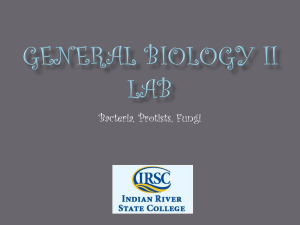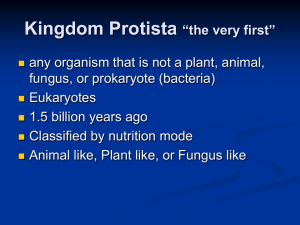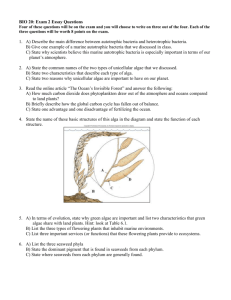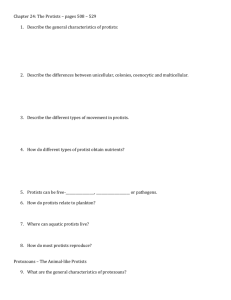Kingdom Protista: Diversity and Classification
advertisement
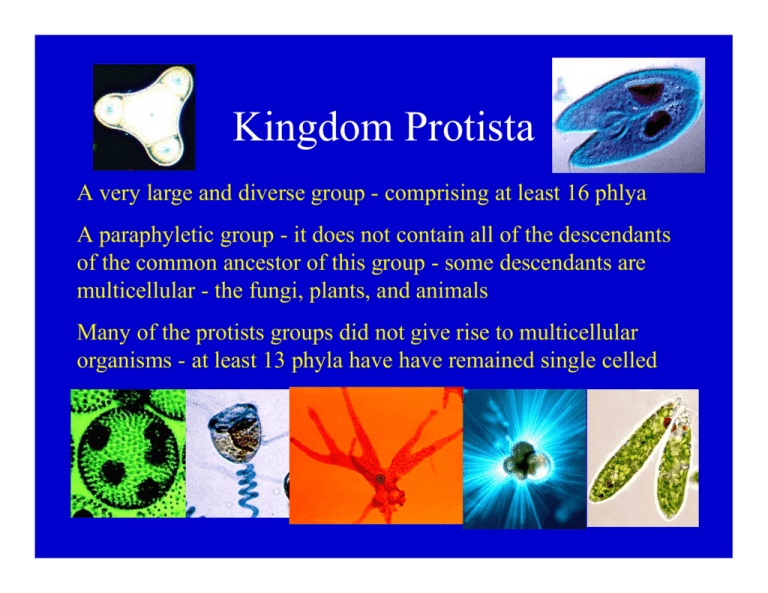
Kingdom Protista A very large and diverse group - comprising at least 16 phlya A paraphyletic group - it does not contain all of the descendants of the common ancestor of this group - some descendants are multicellular - the fungi, plants, and animals Many of the protists groups did not give rise to multicellular organisms - at least 13 phyla have have remained single celled Current classification is changing and likely to change greatly in the near future. Sixteen Phyla comprise the Kingdom Protista classically grouped into 5 informal groups based on mobility and nutrition - differs from evolutionary estimates of relatedness Protistan Diversity The Cell Surface Amoebas lack a cell wall Algae and slime molds encased in strong cell walls Diatoms and Foraminiferans have shells of silica, calcium, debris Locomotor Organelles Many move by flagellar motions, or ciliary action, pseudopodial movement - many are immobile Nutrition Phototrophs and Heterotrophs (phagotrophs (ingesters) and saprobes) Reproduction Asexual reproduction by mitosis, fission, budding, spores Sex by gametic meiosis, zygotic meiosis, or sporic meiosis The Sarcodines - all can have pseudopodia Phylum Rhizopoda - the amoebas Phylum Actinopoda - actinopods, heliozoans Phylum Foraminifera - forams Phylum Rhizopoda - the amoebas Heterotrophic Fresh and salt water, abundant in soil, some parasitize animals Reproduction by simple mitotic fission No cell walls, flagella, sexual reproduction Locomotion via pseudopodia Pseudopodia also used for prey capture Parasitic species may form resistant cysts Entamoeba histolytica : Causes amoebic dysentery Cysts resist digestion by host Carriers exhibit no symptoms but can spread cysts Spread through fecal contamination in food or water may be dispersed by flies Phylum Actinopodia - Actinopods silica (glass) skeletons covering most of cell with many thin needlelike pseudopods that project through pores Phylum Foraminifera - Forams Heterotrophic, marine organisms Possess pore-studded shells called tests tests: organic matter reinforced with inorganic usually multichambered, often spiral shaped material: often calcium carbonate, can use sand grains, echinoderm plates, sponge spicules Podia extrude through pores in test - used for swimming, gathering material for test, feeding White Cliffs of Dover - chalk formed from deposited forams Algae and other photosynthetic protists Phylum Chlorophyta - green algae Phylum Rhodophyta - red algae Phylum Pheophyta - brown algae Phylum Chrysophyta - golden algae and diatoms Phylum Pyrrophyta - dinoflagellates Phylum Euglenophyta - euglenoids Phylum Chlorophyta: Green Algae Ancestors of all plants were multicellular green algae green algae and plants use chlorophylls a and b, carotenoids found in aquatic and semiterrestrial habitats Unicellular and multicellular forms Chlamydomonas is a typical unicellular form biflagellated light sensitive eye-spot zygotic meiosis with zygospore resting stage Some green algae are motile and colonial like Volvox Specialized reproductive cells give rise to new colonies within the parent colony Has zygotic meiosis and zygospores form within a parent colony. Some green algae are filamentous - like Spirogyra named for its spiral chloroplasts Sex is through conjugation of cells from + and - strains Some green algae, like Ulva, form multicellular sheets and have sporic meiosis Except for their ploidy, the gametophytes and sporophytes are very similar Phylum Rhodophyta - Red Algae Most common coastal seaweeds - mostly multicellular, common in warm waters Chloroplasts have Chlorophyll a and phycobilins, like cyanobacteria Absorb green, violet and blue light Grow at greater depths than other algae have sporic meiosis Completely lack flagella Body composed of interwoven filaments An ancient group of eukaryotes Economic importance Some make sulfated polysaccharides like agar and carrageenan Agar used as laboratory medium, a base for cosmetics, used in baked goods and as a temporary preservative for meat and fish Carrageenan used in paints, cosmetics and ice cream Phylum Phaeophyta - Brown Algae Mostly multicellular and marine Conspicuous seaweeds, include kelps and Sargassum Use chlorophylls a and c (like diatoms) Photosynthetically productive - fast growing Provide food for many animals Some kelps grow up to 100 meters in length Have sporic meiosis sporophyte: large, conspicuous kelp-like form gametophyte: small, filamentous form separate male and female gametophytes Phylum Chrysophyta - Diatoms and Golden Algae Diatoms are photosynthetic, unicellular organisms Double shells of silica - Resemble box with lid Use chlorophylls a and c, and carotenoids fossilize well - thick sediments of fossil diatoms are called “diatomaceous earth” Some move by secretions from shell Asexual reproduction separates shell halves each half produces new shell within old one - become smaller with each division Have gametic meiosis - cells are diploid and produce sperm or eggs by meiosis Golden Algae - use yellow and brown carotenoid pigments, and xanthophyll accessory pigments Unicellular, two flagella, often colonial, common in freshwater Form resistant cysts when ponds dry out in summer Phylum Pyrrhophyta - Dinoflagellates Unicellular, photosynthetic, mostly marine, some bioluminescent Distinctive flagella and coat two flagella beat in grooves coat composed of cellulose plates Most use chlorophyll a & c and carotenoids Some are symbiotic with animals sea anemones, mollusks and corals in corals - called “zooxanthellae”, required for formation of coral reefs Some forms cause “red tide” large blooms result in red colored water release toxins that kill fish and shellfish consumption of poisoned fish can kill Reproduce primarily asexually by longitudinal cell division with nuclear mitosis - like fungi Phylum Euglenophyta - Euglenoids Mostly fresh water organisms Group has characteristics of plants and animals Some specimens are photosynthetic use chlorophylls a and b, and carotenoids Others lack chloroplasts and are heterotrophic Some can transform from autotrophs to heterotrophs and back, depending on presence of light and food Reproduction via nuclear mitosis and cell division No sexual reproduction known Euglena is typical Thin flexible pellicle lies within cell membrane - composed of interlocking strips of protein have two flagella - both with bases in reservoir one is very small Contractile vacuoles collect and pump out excess water at reservoir have light sensitive stigma paramylon granules are for food storage Heterotrophs with flagella or cilia Phylum Sarcomastigophora - Zoomastigotes Unicellular, heterotrophic, highly variable in form Possess one to thousands of flagella Some free-living, some parasitic Some reproduce asexually only One group alternates between amoeboid and flagellated stages Some trypanosomes are human pathogens cause sleeping sickness, East Coast fever, Chagas' disease many spread by insects, such as tsetse flies Some inhabit guts of wood-eating insects have enzymes capable of digesting cellulose Choanoflagellates are similar to feeding cells of sponges and are likely ancestors of all animals Hiker's Diarrhea: Caused by Giardia lamblia, found world-wide Occurs in water, infects wild and domesticated animals, and humans Lives in small intestine of host Spreads as cysts in feces, can survive for months in cool water May appear in city water supplies Resistant to treatment with chlorine and iodine, requires boiling water to kill Phylum Ciliophora - The Ciliates Unicellular, heterotrophic, with many cilia Coordinated beating provides motility Outer pellicle is tough but flexible Two types of nuclei micronuclei - diploid - reserved for sex macronuclei - polyploid - for normal cellular metabolism Specialized vacuoles ingest food and contractile vacuoles regulate water balance Food enters through gullet (cytostome) and passes into vacuoles where it is digested Asexual reproduction by transverse fission Sexual reproduction by conjugation Two different mating types exchange haploid micronuclei Macronucleus in each individual disintegrates Multiple rounds of chromosomal replications in micronuclei reconstitutes macronucleus Phylum Apicomplexa - Sporozoans Nonmotile, spore-forming animal parasites Have an “apical complex” at one end of cell - with fibrils, microtubules, and vacuoles - used to enter host cells Have complex life cycles with sexual and asexual phases Exhibit alternation of haploid and diploid generations Fusion of gametes produces a thick-walled cyst, the oocyst Meiotic divisions in oocyst produce infective haploid spores, sporozoites Plasmodium causes malaria Gametocytes become gametes in gut of mosquito syngamy forms zygote and oocyst meiosis in oocyst forms sporozoites Malaria estimated that 500 million infected, 200 million humans die each year, most infected children die symptoms include chills, fever, sweating, enlarged spleen, confusion, thirst - repeating every 48 to 72 hours Victims die of anemia, kidney failure, brain damage Effects can be reduced with drugs Focus is on eradication of malaria through elimination of mosquito carriers Vaccines against malaria may be available in near future Slime Molds Phylum Acrasiomycota - Cellular Slime Molds Phylum Myxomycota -Plasmodial Slime Molds Phylum Oomycota - water molds, rusts, mildew Phylum Acrasiomycota - Cellular Slime Molds Once thought to be related to fungi most closely related to amoebas Common in fresh water, damp soil, rotting vegetation Usually found as free living amoebas Sometimes cells aggregate into motile slug Slug transforms into sorocarp, within sorocarp some amoebas fuse sexually forming diploid macrocysts meiosis occurs in macrocysts - spores released form new amoebas Phylum Myxomycota -Plasmodial Slime Molds Consist of streaming multinucleate plasmodium feeding phase may be yellow, orange or other color Cytoplasm exhibits conspicuous streaming Engulf and digest bacteria, yeast, bits of organic matter forms sporangium under adverse conditions Phylum Oomycota - water molds, rusts, mildew Live in freshwater or soil, many are plant or animal parasites Cell walls are composed of cellulose or similar polymers Body consists of filamentous hyphae Hyphae are diploid (unlike fungi) and produce gametes by meiosis Exhibit normal mitosis (unlike fungi) have unique life cycle Diploid spores produced asexually in sporangium Sex: female gametangium called oogonium with one to eight eggs male gametangium called antheridium with many sperm Fusion produces zygote that becomes thick-walled oospore oospore germinates and forms new hypha

